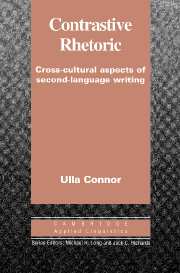Book contents
- Frontmatter
- Contents
- Series editors' preface
- Preface
- I PRELIMINARIES; EARLY PHASES OF THE FIELD
- II INTERFACES WITH OTHER DISCIPLINES
- 4 Contrastive rhetoric and the field of rhetoric and composition
- 5 Contrastive rhetoric and text linguistics
- 6 Writing as an activity embedded in a culture
- 7 Contrastive rhetoric and translation studies
- 8 Genre-specific studies in contrastive rhetoric
- III IMPLICATIONS OF CONTRASTIVE RHETORIC
- References
- Author index
- Subject index
7 - Contrastive rhetoric and translation studies
Published online by Cambridge University Press: 05 October 2012
- Frontmatter
- Contents
- Series editors' preface
- Preface
- I PRELIMINARIES; EARLY PHASES OF THE FIELD
- II INTERFACES WITH OTHER DISCIPLINES
- 4 Contrastive rhetoric and the field of rhetoric and composition
- 5 Contrastive rhetoric and text linguistics
- 6 Writing as an activity embedded in a culture
- 7 Contrastive rhetoric and translation studies
- 8 Genre-specific studies in contrastive rhetoric
- III IMPLICATIONS OF CONTRASTIVE RHETORIC
- References
- Author index
- Subject index
Summary
Contrastive rhetoricians working on second language writing, not only in North America but in other countries, are often unfamiliar with the theories and research of scholars in translation studies. Translation theorists seem to be equally unaware of developments in contrastive rhetoric. This mutual ignorance is curious considering the many goals and research methods these two disciplines have in common. Both are applied rather than theoretical, in the sense that linguistics is used in each field for equally practical purposes: Contrastive rhetoric assists language teaching experts and translation theory assists translators. Both contrastive rhetoric and translation studies deal with first language and second language processing and benefit from the same literature on language acquisition. Both have experienced changes in methodology in the past decade as their individual theories were supplemented with relevant hypotheses and methods of literary study, education, and cognitive science. The explanation for the mutual ignorance may rest in social differences between educational systems: In countries with “small” national languages such as Finland, translation is a must; whereas in countries with “big” languages such as the United States, England, or France, composition is emphasized together with the need to teach ESL.
This chapter addresses three broad issues: first, current theories and practices of translation; second, the issue of “transfer” in contrastive rhetoric and translation theory; and finally, the potential of translation theory to contribute to the solution of some of the outstanding problems in contrastive rhetoric.
- Type
- Chapter
- Information
- Contrastive RhetoricCross-Cultural Aspects of Second Language Writing, pp. 117 - 125Publisher: Cambridge University PressPrint publication year: 1996



